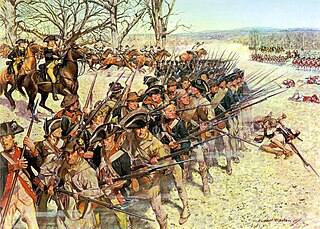
The Battle of Guilford Court House was on March 15, 1781, during the American Revolutionary War, at a site that is now in Greensboro, the seat of Guilford County, North Carolina. A 2,100-man British force under the command of Lieutenant General Charles Cornwallis defeated Major General Nathanael Greene's 4,500 Americans. The British Army, however, suffered considerable casualties.
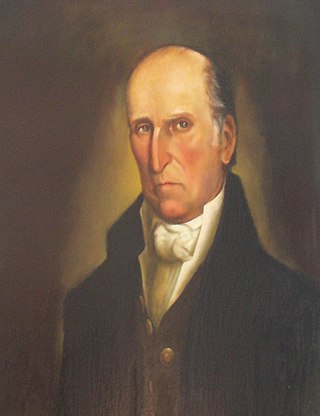
Andrew Pickens was a militia leader in the American Revolution. A planter and slaveowner, he developed his Hopewell plantation on the east side of the Keowee River across from the Cherokee town of Isunigu (Seneca) in western South Carolina. He was elected as a member of the United States House of Representatives from western South Carolina. Several treaties with the Cherokee were negotiated and signed at his plantation of Hopewell.
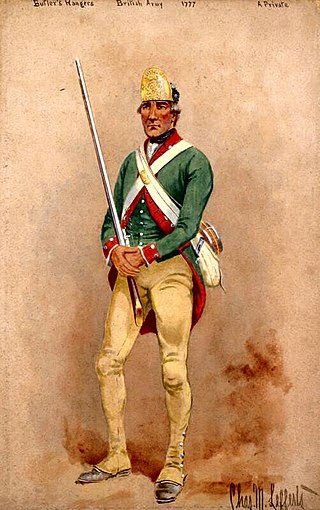
Butler's Rangers (1777–1784) was a Loyalist provincial military unit of the American Revolutionary War, raised by American loyalist John Butler. Most members of the regiment were Loyalists from upstate New York and northeastern Pennsylvania. Their winter quarters were constructed on the west bank of the Niagara River, in what is now Niagara-on-the-Lake, Ontario. The Rangers fought principally in New York and Pennsylvania, but ranged as far west as Ohio and Michigan, and as far south as Virginia and Kentucky.
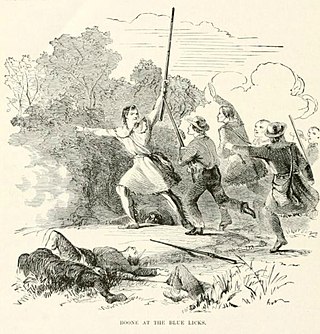
The Battle of Blue Licks, fought on August 19, 1782, was one of the last battles of the American Revolutionary War. The battle occurred ten months after Lord Cornwallis's surrender at Yorktown, which had effectively ended the war in the east. On a hill next to the Licking River in what is now Robertson County, Kentucky, a force of about 50 Loyalists along with 300 indigenous warriors ambushed and routed 182 Kentucky militiamen, who were partially led by Daniel Boone, the famed frontiersman. It was the last victory for the Loyalists and natives during the frontier war. British, Loyalist and Native forces would engage in fighting with American forces once more the following month in Wheeling, West Virginia, during the Siege of Fort Henry.

The Battle of Kings Mountain was a military engagement between Patriot and Loyalist militias in South Carolina during the Southern Campaign of the American Revolutionary War, resulting in a decisive victory for the Patriots. The battle took place on October 7, 1780, 9 miles (14 km) south of the present-day town of Kings Mountain, North Carolina. In what is now rural Cherokee County, South Carolina, the Patriot militia defeated the Loyalist militia commanded by British Major Patrick Ferguson of the 71st Foot. The battle has been described as "the war's largest all-American fight".
Stephen Trigg was an American pioneer and soldier from Virginia. He was killed ten months after the surrender of Cornwallis at Yorktown in one of the last battles of the American Revolution while leading the Lincoln County militia at the Battle of Blue Licks, Kentucky.

The Battle of Moore's Creek Bridge was a minor conflict of the American Revolutionary War fought near Wilmington, North Carolina, on February 27, 1776. The victory of the North Carolina Provincial Congress' militia force over British governor Josiah Martin's and Tristan Worsley's reinforcements at Moore's was a turning point in the war; American independence was declared less than five months later.
William Christian was a military officer, planter and politician from the western part of the Colony of Virginia. He represented Fincastle County in the House of Burgesses and as relations with Britain soured, signed the Fincastle Resolutions. He later represented western Virginia in the Virginia Senate and founded Fort William, as well as helped negotiate the Treaty of Long Island of the Holston, which made peace between the Overmountain Men and Cherokees in 1777. He was killed in 1786 at the outset of the Northwest Indian War, leading an expedition against Native Americans near what is now Jeffersonville, Indiana.

The southern theater of the American Revolutionary War was the central theater of military operations in the second half of the American Revolutionary War, 1778–1781. It encompassed engagements primarily in Virginia, Georgia, North Carolina, and South Carolina. Tactics consisted of both strategic battles and guerrilla warfare.
Robert Lawson was a Virginia lawyer, planter and politician who distinguished himself in the American Revolutionary War, rising to the rank of brigadier general in the Virginia militia. After the conflict, he practiced law, held various political offices and operated a plantation in Prince Edward County, Virginia, but also suffered from alcoholism, which caused his estrangement from his family as well as being swindled. As discussed by the United States Supreme Court in Wagner v. Baird, 48 U.S. 234 (1849), although granted over 10,000 acres of land in what became the state of Ohio, Lawson transferred those rights to a swindler, so decades later his heirs unsuccessfully sought redress.

William Russell was an army officer and a prominent settler of the southwestern region of the Virginia Colony. He led an early attempt to settle the "Kentuckee Territory". He was a justice of Fincastle County, Virginia. During the American Revolutionary War he fought in the Battle of Yorktown. While a representative in the Virginia House of Delegates, Russell was noted for his stance opposing the 1785 State of Franklin petition for admittance into the United States.
The Battle of Wetzell's Mill was an American Revolutionary War battle fought on March 6, 1781, between detachments of Nathanael Greene's Continental Army and militia and Banastre Tarleton's Loyalist provincial troops in Guilford County, North Carolina.

The Battle of Blandford, also called the Battle of Petersburg, took place near Petersburg, Virginia on 25 April 1781, late in the American War of Independence. Roughly 2,300 British regulars under the command of Brigadier General William Phillips defeated about 1,000 militia under Major General Baron von Steuben.

James John Floyd was an early settler of St. Matthews, Kentucky, and helped lay out Louisville. In Kentucky, he served as a Colonel of the Kentucky Militia in which he participated in raids with George Rogers Clark and later became one of the first judges of Kentucky.
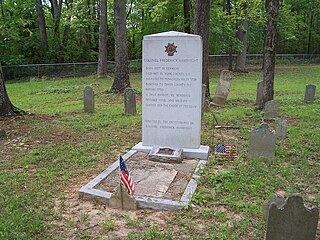
Frederick Hambright was a military officer who fought in both the local militia and in the North Carolina Line of the Continental Army during the Revolutionary War. He is best known for his participation in the Battle of Kings Mountain in 1780. Serving as a statesman early in the Revolution, Hambright joined the war in 1777, ranked a lieutenant colonel in a local militia. His early actions were limited to occasional checks on Loyalist groups. This changed in 1780 with Hambright's important role at the Battle of Kings Mountain, which occurred near his lands in the newly formed Lincoln County, North Carolina. Hambright was commended for his bravery during the battle, though suffering a wound which forced him to permanently resign from military service.
Elizabeth Henry Campbell Russell, was a Methodist lay leader from the United States of America who is credited with bringing Methodism to western Virginia and northeastern Tennessee.
Arthur Campbell was a soldier in the Indian Wars and the American Revolutionary War as well as a member of the Virginia House of Delegates. Campbell County, Tennessee, was named after him.
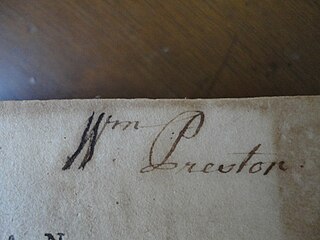
Colonel William Preston was an Irish-born American military officer, planter and politician. He played a crucial role in surveying and developing the Southern Colonies, exerted great influence in the colonial affairs of his time, owned numerous slaves on his plantation, and founded a dynasty whose progeny would supply leaders of the South for nearly a century. He served in the House of Burgesses and was a colonel in the Virginia militia during the American Revolutionary War. He was one of the fifteen signatories of the Fincastle Resolutions. Preston was also a founding trustee of Liberty Hall when it was transformed into a college in 1776.
Thomas Eaton was a military officer in the North Carolina militia during the War of the Regulation in 1771 and American Revolutionary War from 1775 to 1784. He was a member of the North Carolina Provincial Congress and North Carolina House of Commons for several terms simultaneously with his military service. Eaton was a member of the North Carolina Council of State under Governor Richard Caswell. Eaton commanded soldiers in the battles of Brier Creek and Guilford Courthouse. At the time of the 1790 census, Eaton was one of the largest slaveholders in North Carolina.
Anthony Bledsoe was an American surveyor, politician and military colonel. He served in the French and Indian War and the American Revolutionary War.











